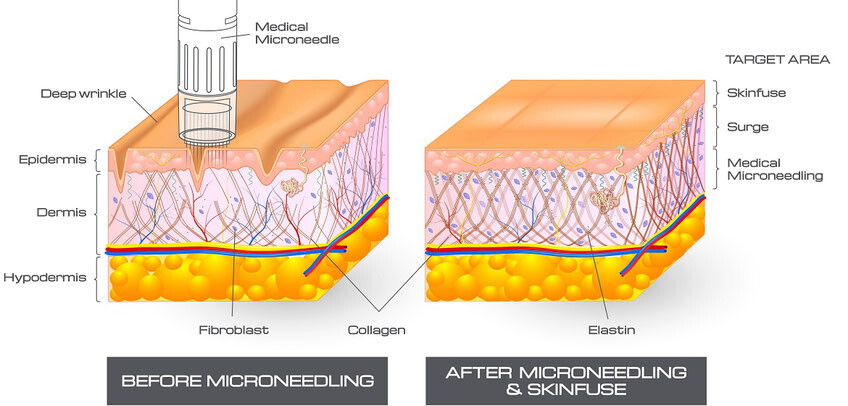- How it works
- What is involved with a microneedling treatment?
- Pre-treatment instructions
- Contraindications
- Post-treatment instructions
- Where else can you have microneedling?
- How does microneedling help with resurfacing?
Microneedling is a therapy that creates “micro-injuries” to the skin, inducing the healing process including new collagen and elastin production. It is a non-invasive treatment that is safe for all skin types. It creates microchannels using medical grade needles to a precise depth (which varies by skin type and treatment area) to create a controlled injury to stimulate your skin to repair. When the microchannels are open, treatment boosters may be use to penetrate and improve the skin even more. Treatments are performed in a safe and precise manner with the sterile devices and are normally completed within 30-60 minutes, depending on the selected area.
Benefits of Microneedling
- Overall improvement to skin texture & tone
- Improves the appearance of acne scars, dark spots, large pores, stretch marks, and uneven skin
- Smooths fine lines, scars due to surgery or injury
- Natural looking results – no change in facial expressions
- Long-lasting results – regenerating your body’s own tissues
- Reduced wrinkles – filler effect directly tackles facial lines
- More luminous skin – treatment leads to brighter skin tone
The most common treatment areas include the face, neck, decolletage and hands, and scalp but the microneedling therapy can also be used on other parts of the body.
Before the procedure, the skin is anesthetized with an ointment to provide the client with maximum comfort. In preparation for the microneedling, the treatment area is disinfected. Topical or injectable boosters may be added for additional benefits. Options can be reviewed with your provider.
After the procedure, the skin may appear swollen and possibly flushed. In most cases, everything disappears in the next few days. Aftercare is recommended for optimal healing and results.
The skin condition will improve over time as a result of regenerative processes.
Avoid the use of non-steroidal anti-inflammatory drugs (NSAIDs like aspirin, Motrin, Advil, ibuprofen, or any other non-Tylenol, non-acetaminophen product) for two weeks prior to treatment to minimize the potential for bruising. Discuss any current medications that you are taking with your doctor prior to stopping or pausing usage.
Hydrate: for seven days prior, moisturize your skin in the morning & evening.
Stop all topical acids (like glycolic, alpha, or beta hydroxyl acids), retinol, Retin-A, or other like products 7 days prior to treatment.
Avoid tanning beds or prolonged exposure to the sun 14 days prior to treatment. Always use a zinc oxide sunscreen with SPF 30+.
Remove all substances from the intended treatment area, including topical numbing cream, tanning products, ointments, lotions, perfumes, bath/shower oils, deodorants, etc.
The following are recognized as known contraindications to micro-needling.
- Allergies to Nickel or stainless steel
- Collagen vascular diseases
- Active acne
- Active infection of any type (bacterial, viral, or fungal)
- Long term use of Prednisone and other steroid medications (treatment will increase inflammation)
- Connective tissue disorders / auto immune disorders (e.g. lupus)
- Undergoing chemotherapy or immune therapy
- Blood thinner medications
- Cardiac disease/abnormalities
- Chemotherapy or radiation
- Collagen Vascular Disease
- Hemophilia / bleeding disorders
- Hormone Replacement Therapy
- Keloid/hypertrophic scaring
- Pregnancy / Lactation
- Raised lesions (moles, warts, etc.)
- Recent chemical peel procedure
- Recent use of some topical rx.
- Rosacea
- Scleroderma
- Skin Cancer
- Solar keratosis
- Treating over tattoos or permanent makeup
- Telangiectasia/erythema
- Uncontrolled diabetes
- Vascular lesions (hemangiomas)
- Under 18 years of age
- Any active condition in the treatment area, such as sores, psoriasis, eczema and rash as well as excessively/freshly tanned skin
- Excessively tanned skin from sun, tanning beds or tanning creams and sprays within the last two weeks.
- Currently taking antibiotics
- Any surgical procedure in the treatment area within the last three months or before complete healing.
- Use of Isotretinoin (Accutane®) within 6 months prior to treatment
- Cosmetic treatments including neurotoxins, filler, threads, Sculptra will need to be evaluated for possible contraindications.
- Any surgical, invasive, ablative procedure in the treatment area in the last 3 months or before complete healing
- Any medical condition that might impair skin healing
- History of skin disorders such as keloid scarring, abnormal wound healing, as well as very dry and fragile skin
- Severe concurrent conditions such as cardiac disorders, epilepsy, uncontrolled hypertension, and liver or kidney diseases
- ·A history of diseases stimulated, such as recurrent Herpes Simplex in the treatment area
Immediately after treatment PRP or the EGF serum may be used on treatment area to help boost results.
After 24 Hours the post care skincare routine may be initiated:
- Wash skin with the Gentle Cream Cleanser with cool water. Avoid using towels or abrasive scrubbing cleansing cloths. Pat dry once rinsed with water.
- Tone skin with the Calming Flower Mist.
- Apply post care safe serums after toning options include: Phyto Calm Aloe Drops, EGF Drops, or Antistress CBD.
- Additional post care safe serums include the HA Revive Hydrator Dops or Daily Hydration Drops.
- Moisturize with the Phyto Calm Hydrator or Vita E Moisturizing Cream.
- Apply SPF of 30 or higher 15 minutes before sun exposure and reapply as needed.
Additional advisories:
Expected downtime can vary depending on treatment settings and may range between 1-7 days. The expected healing sequence and expected treatment side effects include redness, swelling, bruising, light discomfort, and pinpoint bleeding.
During the healing process keeping the items in contact with treatment areas in clean. This may include: clean pillow cases, linens, wiping down cell phones or any accessories coming in contact with treated skin with alcohol.
Avoid touching: Avoid touching or picking at your skin.
Avoid washcloths, cleansing brushes and harsh cleansers until all transient healing processes have resolved naturally.
Sleep with a slight elevation of your head to help with any swelling.
Avoid sleeping with pets for 24 hours
Avoid excessive sun exposure in the treatment area and use sunscreen (SPF 30+) for one month following the procedure.
Avoid heat: Avoid hot tubs, saunas, steam rooms, and excessive exercise for at least 48-72 hours after treatment.
Contact the office if you have any concerns about how your skin is responding to treatment or is healing.
If you are healing well, you may resume using mineral makeup 24-48 hours later. Do not resume the use of topical acids, retinol, Retin-A, etc. for 7 days.
Some people may experience breakouts after a skin needling treatment. This is typically due to the release of debris and toxins from the deep layers of the skin. Breakouts usually resolve within 1-2 weeks.
If you are healing well, you may resume using mineral makeup 24 hours later. Do not resume the use of topical acids, retinol, Retin-A, etc. for 7 days.
The most common treatment areas include the face, neck, decolletage and scalp but the microneedling can also be used on the breast, buttocks, abdomen, knees, thighs, and almost any other body area.
Microneedling causes a natural response to produce new collagen-rich tissue. Generation of new, collagen-rich tissue tightens skin, reduces scars, wrinkles, stretch marks and fine lines in the skin. This thus improves the overall texture and appearance of your skin.


